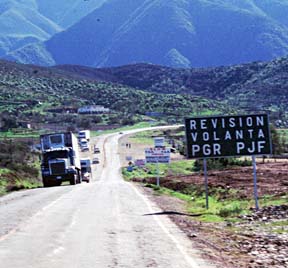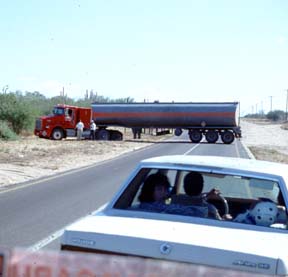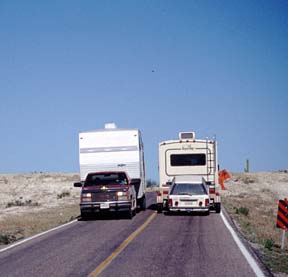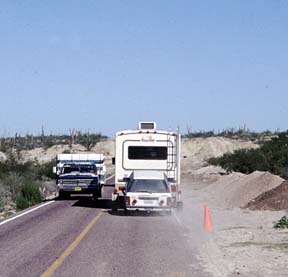
Joys of Mex 1: Baja's Transpeninsular Highway
![]()
|
Heading down Mex 1, Baja's 1,070-mile-long Transpeninsular Highway. Clockwise from left, a drug/gun inspection south of Maneadero; fender bender south of La Paz; Mexican tight squeeze north of Los Barriles; American tight squeeze south of Ciudad Constitucion; the same wide rig meeting the locals a few miles later; your friends, the cows. |
ADVENTURE AND FUN ON A 1,000-MILE LONG, 2-LANE ROAD
Aug, 30, 2000, by Gene Kira, Western Outdoor News:
Here, from The Unforgettable Sea Of Cortez, are a couple of interesting quotations about the opening of Mex 1, Baja's Transpeninsular Highway in 1973:
"One of the first effects of the opening of Mex 1 was there were dead and maimed people all over Baja." --Mark Walters, Rancho Buena Vista.
"We are going to lose tranquility, but are going to make a lot of money." --Luis Bulnes, Hotel Solmar, Cabo San Lucas.
These two Baja legends hit it right on the head. Over the last quarter-century, the Transpeninsular Highway certainly has been a watershed in the creation of dead and maimed people--and heaps of money--all up and down the Baja California peninsula.
Let's talk about the dead and maimed people...
|
|
Probably, the most amazing thing about Mex 1 is that so many of us tourists actually survive driving down it. Our survival rate is compelling evidence for the essential benevolence of the universe. Read all the books you want. Join the clubs. Get the maps. Buy the Mexican insurance. Take all possible precautions. On Mex 1, you are still nothing but dead dog meat, just waiting to happen.
Over the course of about 200 trips down Mex 1, I've averaged seeing the fresh remains of a little more than one serious accident per trip. The record is five accidents on one trip: an overturned truck, an RV into the boulders, an overturned car, and a head-on collision between two ambulances in downtown La Paz. On the way home, we passed another burning truck, full of five tons of watermelons, just south of El Rosario. Don't try to tell me you can't burn a watermelon.
There just seems to be something about Baja that causes people to have car accidents. One of my favorite stories about Baja's early years is from San Jose del Cabo. In the late 1920s, one of the town's leading families acquired and somehow imported one of the first motor vehicles into Baja California Sur, a brand new Ford Model A. Shortly thereafter, a second leading family responded by also buying a Model A and bringing it to town. Within two weeks, both cars were totaled in a head-on collision.
See? I told you so.
Another favorite story involves a description I wrote in The Baja Catch about encountering "a two-foot high tidal wave of ripe tomatoes" blocking the entire road. Ralph Poole, old-time Baja 1000 hero and now publisher of Trailer Boats magazine, called once to say that he was guffawing skeptically over that passage as he and a friend were driving up Mex 1 and reading the book. Just as he got to the part about the tomatoes, they rounded a bend in the road and ran right into a wall of...yup! ripe tomatoes! Serves you right, Ralph.
Or, there was time when my son and I were driving north beside Bahia Concepcion and we found the highway blocked by an overturned sedan, burning brightly, right in the middle of the road. A young Mexican man was sitting on the pavement about 50 feet from the burning car, cradling the head and shoulders of a young woman in his arms. Both of them were smartly dressed in sparkly, city-style clothes. I jumped out and ran to their aid, keeping a safe distance from the car, which looked like it could explode at any moment.
|
|
As I reached them, the young woman's eyes flew open, and she gasped, in English, "Arturo!! Your briefcase!!!" Arturo dropped her like a sack of potatoes, wrapped a jacket around his head, and dived right into the window of the overturned car. All we could see of him were the soles of his shoes. With singed hair and jacket smoking, he emerged with his briefcase and made a run for it to avoid getting caught in the small explosions that were starting to happen. Since the woman was bleeding a fair amount, we loaded her into my pickup and made a dash for the clinica in Mulege, and all the way in, Arturo guarded that briefcase like a mother hen. I didn't ask them what kind of business they were in.
But probably, the richest vein of Baja road stories concerns driving at night. Seems like everyone warns against it, and then they go out and do it anyway, and eventually they pay the price. One night in Guerrero Negro, I met two Americans being towed into town by a pickup truck. The front of their van had a cow-shaped imprint in it that reached all the way to the back seats. It was amazing they were still alive. The driver's comment explained it all: "NEVER drive at night! God! Just look at what a cow does to you at 85 miles and hour!" I swear, that's exactly what he said.
I don't recommend it, but actually, I feel safer on the Transpeninsular Highway at night. There are several reasons for this, probably the foremost of which is that my natural cowardliness causes me to slow way down, sometimes down to as little as 20 miles-per-hour. At that speed, it's pretty hard to have an accident, even with a black cow in a fog bank. Also, most of the busses and trucks have gone to bed by about 10 p.m., and even better, the RVs and the big boat trailers are safely stowed away for the night in the parking lots. And best of all, at night, the remaining idiots on the road, like me, usually drive very cautiously; the foolhardy ones get weeded out pretty quickly.
(Related Baja California, Mexico, articles and reports may be found at Mexfish.com's main Baja California information page. See weekly fishing news, photos, and reports from the major sportfishing vacation areas of Mexico including the Baja California area in "Mexico Fishing News.")
MEXICO FISHING INFO BAJA FISHING INFO "WEEKLY MEXICO FISHING NEWS" FISH PHOTO GALLERY





